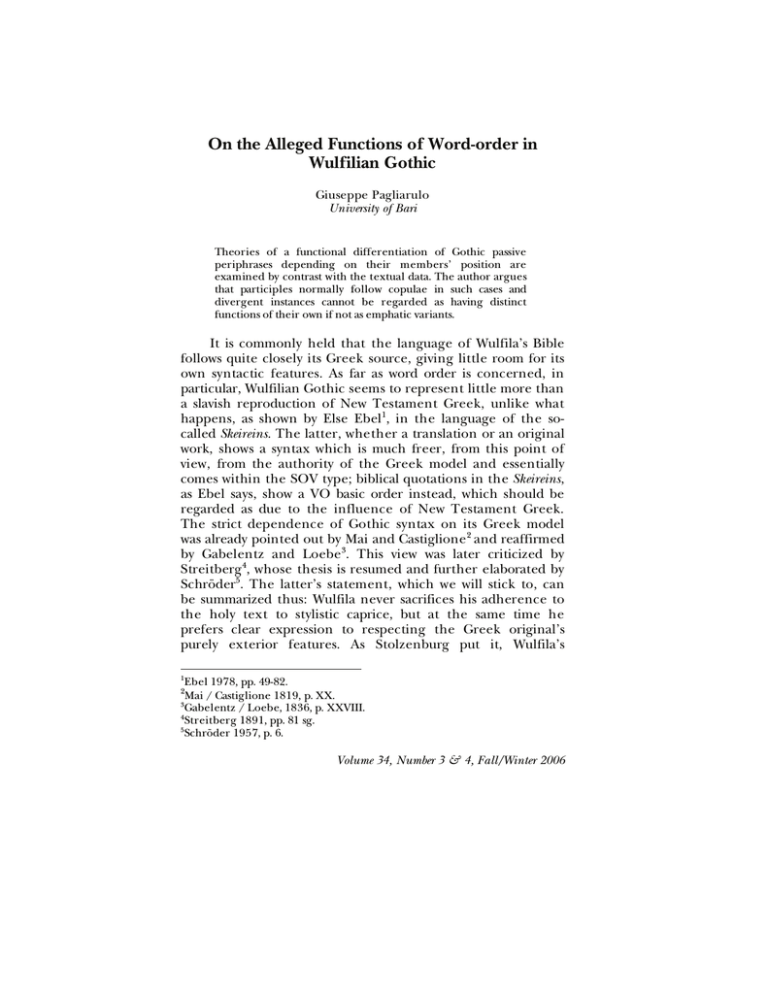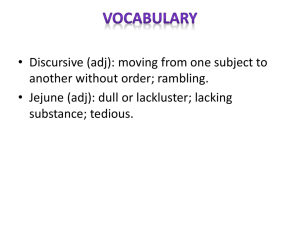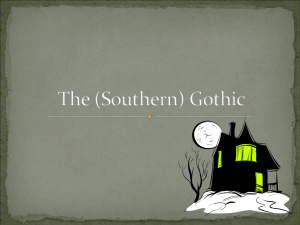
On the Alleged Functions of Word-order in
Wulfilian Gothic
Giuseppe Pagliarulo
University of Bari
Theories of a functional differentiation of Gothic passive
periphrases depending on their members’ position are
examined by contrast with the textual data. The author argues
that participles normally follow copulae in such cases and
divergent instances cannot be regarded as having distinct
functions of their own if not as emphatic variants.
It is commonly held that the language of Wulfila’s Bible
follows quite closely its Greek source, giving little room for its
own syntactic features. As far as word order is concerned, in
particular, Wulfilian Gothic seems to represent little more than
a slavish reproduction of New Testament Greek, unlike what
happens, as shown by Else Ebel 1, in the language of the socalled Skeireins. The latter, whether a translation or an original
work, shows a syntax which is much freer, from this point of
view, from the authority of the Greek model and essentially
comes within the SOV type; biblical quotations in the Skeireins,
as Ebel says, show a VO basic order instead, which should be
regarded as due to the influence of New Testament Greek.
The strict dependence of Gothic syntax on its Greek model
was already pointed out by Mai and Castiglione 2 and reaffirmed
by Gabelentz and Loebe 3. This view was later criticized by
Streitberg 4, whose thesis is resumed and further elaborated by
Schröder5. The latter’s statement, which we will stick to, can
be summarized thus: Wulfila never sacrifices his adherence to
the holy text to stylistic caprice, but at the same time he
prefers clear expression to respecting the Greek original’s
purely exterior features. As Stolzenburg put it, Wulfila’s
1
Ebel 1978, pp. 49-82.
Mai / Castiglione 1819, p. XX.
3
Gabelentz / Loebe, 1836, p. XXVIII.
4
Streitberg 1891, pp. 81 sg.
5
Schröder 1957, p. 6.
2
Volume 34, Number 3 & 4, Fall/Winter 2006
438
Giuseppe Pagliarulo
translation is generally slavish but not so slavish as to exclude
recourse to Gothic idiomatic structures when necessary6. As for
word order in Wulfilian Gothic, scholars looking for a sound
field of investigation basically have to content themselves with
those cases in which the necessities of translation make a
direct transposition from Greek into Gothic impossible or
decidedly inelegant. Among these are all Greek synthetic
forms for which Wulfila lacks any exact equivalent and has to
resort to periphrastic renderings.
Koppitz was one of the first to note that Gothic verbs, if
present, normally keep the last position in periphrastic
renderings of single Greek terms7. In introducing his work,
however, Koppitz makes it clear that general statements
regarding the position of verbs in the Gothic sentence are
excluded from it, as the available textual data do not seem
sufficient to allow sound conclusions to be drawn8. He
extensively considers the places where a single Greek term is
translated by a verb-noun, verb-pronoun or verb-adverb
syntagm. The only case, among these, where the verb does
not regularly occupy the last position is the second.
The analysis is methodically resumed by Fourquet 9 who
reaffirms, even for the periphrastic passive and for adjectiveverb syntagms in general, the verb’s tendency to follow the
predicate, a tendency occurring with almost perfect regularity
except when the verb is an imperative form10 or the
periphrasis is preceded by a negative particle. In this case the
predicate-verb order is kept in crystallized expressions such as J
10:13 oÙ mšlei ni kar-ist (note the elision). Fourquet
hypothesizes that locutions with predicate-verb order are to be
taken as single logical units, while locutions with verbpredicate order as a fusion of two functionally distinct
elements 11. The general principle he follows is: la traduction
d’un mot unique a nécessairement la valeur d’une seule unité
semantique 12.
Such an attribution of different functions to periphrases
6
Stolzenburg 1905, p. 385.
Koppitz 1900, p. 458.
8
Ibidem, p. 433.
9
Fourquet 1938, pp. 234-284.
10
This had already been pointed out in Meillet 1908, p. 97.
11
Fourquet 1938, p. 255.
12
Ibidem, p. 259.
7
The Journal of Indo-European Studies
On the Alleged Functions of Word-order in Wulfilian Gothic
439
depending on their members’ position is proposed again by
Ambrosini in his study on Gothic modal verbs13 and by
Benveniste in his article about the functions of «to be» and
«to have» 14. Benveniste’s views are later adopted by Ramat15.
These scholars do not just assume that periphrases with
predicate-verb order are to be read as semantic units, while
periphrases with verb-predicate order are to be read as a
coming together of two distinct elements. Ambrosini
recognizes a «prevalence of the temporal over the modal
meaning» in periphrases showing the modal verb in second
position; Benveniste states that periphrases with wisan and a
past participle have a temporal value (they are to be read as a
“perfect”, in Benveniste’s own words) only when the copula
follows the participle: otherwise what we have is predicative
syntagms.
Ambrosini, however, draws his conclusions from only five
cases in which the modal verbs haban and duginnan + infinitive
translate a Greek future, and this without taking into account
the general behaviour of Gothic periphrases. The problem is
further examined by Anna Martellotti, who notes that the
modal verb skulan (which is never employed to translate a
Greek future) appears after the infinitive it governs when the
Greek text in turn postponed de‹ or Ñfe…lein, which skulan
translates 16. Duginnan is similarly postponed in the only case 17
in which proen£rcesqai, the verb it translates, is postponed in
the Greek text. In all other cases the Greek text shows a
modal-infinitive order and this is faithfully reproduced in
Gothic. Of great significance is Mk 8:31,
de‹ tÕn uƒÕn toà ¢nqrèpou poll¦ paqe‹n kaˆ ¢podokimasqÁnai
ØpÕ tîn presbutšrwn kaˆ tîn ¢rcieršwn
skal sunus mans filu winnan jah uskiusan skulds ist fram þaim
sinistam jah þaim auhumistam gudjam
13
Ambrosini 1965, pp. 87-101.
Benveniste 1966, pp. 223-247.
15
Ramat 1981, p. 233.
16
Lk 4:43 eÙaggel…sasqa… me de‹ t¾n basile…an toà qeoà wailamerjan ik skal bi
þiudangardja gudis; 2Thess 1:3 eÙcariste‹n Ñfe…lomen tù qeù awiliudon skulum
guda; 2Cor 5:10 toÝj g¦r p£ntaj ¹m©j fanerwqÁnai de‹ œmprosqen toà b»matoj
toà Cristoà allai weis ataugjan skuldai sijum faura stauastola Xristaus.
17
2Cor 8:10 toàto g¦r Øm‹n sumfšrei, o†tinej oÙ mÒnon tÕ poiÁsai ¢ll¦ kaˆ tÕ
qšlein proen»rxasqe ¢pÕ pšrusi unte þata izwis batizo ist, juzei ni þatainei taujan,
ak jah wiljan dugunnuþ af fairnin jera.
14
Volume 34, Number 3 & 4, Fall/Winter 2006
440
Giuseppe Pagliarulo
where Wulfila, having the necessity to reintroduce skulan (in
the locution skulds ist) to allow for a passive reading of the
infinitive uskiusan, adds the modal verb after it independently
of the Greek text, which makes both paqe‹n and
¢podokimasqÁnai depend on the preceding de‹, translated by
skal in the first instance; and surely there is no detectable
functional difference of a temporal kind here between skal
winnan and uskiusan skulds ist. Putting the Gothic modal verb
after the infinitive it governs, therefore, seems to be a
mechanical fact devoid of any semantic relevance 18.
If such a functional distinction based on word order does
not seem admissible for modal verbs, we may ask whether the
position of passive auxiliaries wisan and wairþan is governed by
simply mechanical principles or, as Benveniste and Ramat
claim, it is indeed a sign of a distinction in meaning.
Ancient Greek has a synthetic mediopassive perfect,
which is a typical feature of this language 19, and a periphrastic
perfect formed by juxtaposition of a perfect mediopassive
participle and the present tense of e„m…. This periphrasis was
originally limited to all persons of the subjunctive and of the
optative and to the third person plural indicative of consonant
stems20, but it is extended to all persons of the indicative in
New Testament Greek 21. The Greek mediopassive perfect
indicative, in its synthetic as well as periphrastic forms, finds its
most frequent rendering in the periphrasis with wisan and the
preterite participle: we have counted 73 cases translated thus,
against four cases translated by wairþan with a preterite
participle and six cases translated by synthetic passive forms. In
rendering the periphrastic perfect by means of a wisanperiphrasis Gothic unexceptionably follows the Greek word
order:
Mt 10:26 ™stin kekalummšnon ist gahuliþ
Mt 10:30 ºriqmhmšnai e„s…n garaþana sind
J 6:31 ™stin gegrammšnon ist gameliþ
J 6:65 Ï dedomšnon ist atgiban
J 10:34 œstin gegrammšnon ist gameliþ
J 12:14 ™stin gegrammšnon ist gameliþ
18
Martellotti 1975, pp. 354-355.
Watkins 1969, p. 131.
20
Basile 2001, p. 396.
21
DeWitt Burton 1898, § 84.
19
The Journal of Indo-European Studies
On the Alleged Functions of Word-order in Wulfilian Gothic
441
J 16:24 Ï peplhrwmšnh sijai usfullida
J 17:23 ðsin teteleiwmšnoi sijaina ustauhanai
Rm 13:1 tetagmšnai e„s…n gasatida sind
2Cor 4:3 œstin kekalummšnon ist gahulida (two times)
2Cor 9:3 pareskeuasmšnoi Ãte gamanwidai sijaiþ
Eph 2:5 ™ste sesJsmšnoi sijuþ ganasidai
Eph 2:8 ™ste sesJsmšnoi siuþ ganasidai.
When rendering synthetic mediopassive perfect forms,
wisan always follows the participle, with only two exceptions
out of 62 occurrences:
J 8:41 gegenn»meqa sijum gabauranai
1Cor 7:15 oÙ dedoÚlwtai nist gaþiwaids
and in the latter the auxiliary’s position seems to be
conditioned by the negative particle ni 22, so that Benveniste
appears to be justified in saying that the reverse order, with
«to be» preceding the adjective, designates a predicative
syntagm, not a perfect: he compares was gadraban to its Greek
model Ãn lelatomhmšnon23; moreover, he compares Gothic to
Latin, which, having a periphrastic passive perfect structurally
similar to the Gothic wisan + preterite participle periphrasis,
similarly puts the auxiliary before the participle when the
periphrasis is a descriptive form, not a true perfect 24:
J 20:30-31 poll¦mn noân kaˆ ¥lla shme‹a
™po…hsen Ð 'Ihsoàj ™nèpion tîn maqhtîn
[aÙtoà], § oÙk œ st in gegr a mmš na ™n tù
bibl…J toÚtJ: taàta d gšg rap ta i †na
pisteÚ[s]hte
multa quidem et alia signa fecit Iesus in conspectu
discipulorum suorum quae non sunt scripta in
libro hoc haec autem scripta sunt ut credatis.
Just like Ambrosini, however, Benveniste does not
consider this phenomenon in the wider perspective of the
behaviour of Gothic periphrases and, in general, of Gothic
predicative syntagms.
If Gothic regularly follows Greek word order when
22
Fourquet 1938, p. 253.
The example is taken from Mk 15:46.
24
Benveniste 1966, p. 242.
23
Volume 34, Number 3 & 4, Fall/Winter 2006
442
Giuseppe Pagliarulo
rendering periphrases, putting the auxiliary, however, after
the participle with the same regularity when translating Greek
synthetic forms, we have good reason to suspect that the
former fact, too, may represent a mere reproduction of Greek
syntactic features – and in any case it seems highly doubtful
that we are dealing with Gothic idiomatic structures here. We
must remember that modal verbs show identical behaviour, as
does the wairþan-passive. This has a predicate-verb order in no
more than two renderings of synthetic Greek forms:
Mk 2:27 tÕ s£bbaton di¦ tÕn ¥nqrwpon ™gšneto
sabbato in mans warþ gaskapans
1Tm 2:14 'Ad¦m oÙk ºpat»qh Adam ni warþ uslutoþs
and in the second case the auxiliary’s position seems
influenced by the negative particle ni. The wairþan + preterite
participle periphrasis, unlike wisan-periphrases, translates
almost exclusively synthetic Greek forms and thus appears
almost always with a predicate-verb order. In the (rare)
renderings of g…nomai or e„m…-periphrases it unexceptionably
follows Greek word order:
J 12:42 ¢posun£gwgoi gšnwntai uswaurpanai waurþeina
Lk 6:40 kathrtismšnoj d p©j œstai gamanwids
arjizuh wairþai
Lk 10:21 ™gšneto eÙdok…a warþ galeikaiþ
Lk 14:12 gšnhtai ¢ntapÒdom£ soi wairþiþ þus usguldan
Mk 9:50 ¥nalon gšnhtai unsaltan wairþiþ
1Cor 9:27 ¢dÒkimoj gšnwmai uskusans wairþau
1Tm 2:14 ™xapathqe‹sa ™n parab£sei gšgonen
uslutoda in missadedai warþ
Neh 6:16 ™gen»qh teleiwqÁnai tÕ œrgon warþ
usfulliþ þata waurstw.
In like manner the wisan-periphrasis follows Greek word
order when translating e„m…-syntagms which cannot be
classified as periphrastic perfect forms.
This is the case with the periphrastic pluperfect:
Mt 9:36 Ãsan ™skulmšnoi kaˆ ™rrimmšnoi wesun
afdauidai jah frawaurpanai
J 12:16 Ãn gegrammšnon was gamelid
J 19:11 Ãn dedomšnon soi wesi þus atgiban
Lk 2:26 Ãn aÙtù kecrhmatismšnon was imma gataihan
The Journal of Indo-European Studies
On the Alleged Functions of Word-order in Wulfilian Gothic
443
Lk 4:16 Ãn teqrammšnoj was fodiþs
Lk 4:17 Ãn gegrammšnon was gamelid
Lk 5:17 Ãsan sunelhluqÒtej wesun gaqumanai
Lk 8:2 Ãsan teqerapeumšnai wesun galeikinodos
Lk 9:32 Ãsan bebarhmšnoi wesun kauridai
Lk 9:45 Ãn parakekalummšnon was gahuliþ
Lk 15:24 ¢polwlëj Ãn fralusans was
Mk 1:6 Ãn Ð 'Iw£nnhj ™ndedumšnoj wasuþ-þan
Iohannes gawasiþs
Mk 1:33 ™pisunhgmšnh Ãn garunnana was
Mk 15:7 Ãn d Ð legÒmenoj Barabb©j met¦ tîn
stasiastîn dedemšnoj wasuh þan sa haitana
Barabbas miþ þaim miþ imma drobjandam
gabundans
Mk 15:26 Ãn ¹ ™pigraf¾ tÁj a„t…aj aÙtoà
™pigegrammšnh jah was ufarmeli fairinos is
ufarmeliþ
Mk 15:46 Ãn lelatomhmšnon was gadraban
Gal 2:11 kategnwsmšnoj Ãn gatarhiþs was
with the only exception of J 3:24 Ãn beblhmšnoj galagiþs was,
which is, however, unattested in Wulfila’s Bible and known to
us only by indirect tradition (Skeireins 3:2) 25.
This is also the case with e„m… and aorist or present
participles:
Lk 4:38 Ãn sunecomšnh was anahabaida
Mk 5:41 ™stin meqermhneuÒmenon ist gaskeiriþ
Mk 15:22 ™stin meqermhneuÒmenon ist gaskeiriþ
Mk 15:34 ™stin meqermhneuÒmenon ist gaskeiriþ
Rm 7:3 e‰nai aÙt¾n moical…da genomšnhn sijai
horinondei waurþana
1Cor 5:11 ÑnomazÒmenoj Ï namnids sijai
Gal 1:22 ½mhn d ¢gnooÚmenoj wasuþ-þan unkunþs
Gal 4:24 ™stin ¢llhgoroÚmena sind aljaleikodos
Neh 5:18 Ãn ginÒmenon was fraquman
and with predicative syntagms or other periphrastic Greek
expressions:
J 7:49 ™p£rato… e„sin fraqiþanai sind
J 9:21 ¹lik…an œcei uswahsans ist
25
See Del Pezzo 1973, p. 9.
Volume 34, Number 3 & 4, Fall/Winter 2006
444
Giuseppe Pagliarulo
J 9:23 ¹lik…an œcei uswahsans ist
J 18:15 Ãn gnwstÒj was kunþs
Mk 9:6 Ãsan g¦r œkfoboi wesun auk usagidai
1Cor 5:7 ™ste ¥zumoi sijaiþ unbeistjodai
1Cor 10:28 ƒerÒqutÒn ™stin gasaliþ ist
1Cor 7:11 menštw ¥gamoj wisan unliugaidai
2Cor 13:5 ¢dÒkimo… ™ste ungakusanai sijuþ
2Cor 13:6 ™smn ¢dÒkimoi sijum ungakusanai
Col 3:20 eÙ£restÒn ™stin26 waila galeikaiþ ist
Eph 5:10 ™stin eÙ£reston sijai waila galeikaiþ
Phil 4:11 aÙt£rkhj e‰nai ganohiþs wisan
1Thess 4:9 qeod…dakto… ™ste uslaisidai sijuþ
1Tm 5:7 ¢nep…lhmptoi ðsin ungafairinodos sijaina
2Tm 3:17 ¥rtioj Ï ustauhans sijai
Tt 1:7 ¢nšgklhton e‰nai ungafairinoþs wisan.
In order to reach sound conclusions in this field it seems
preferable to draw our attention to those places where Gothic
is forced to show a certain autonomy from its source,
translating synthetic expressions by means of predicative
syntagms. A first possibility worth considering is the rendering
of synthetic forms by threefold syntagms, i. e. syntagms made
up of a periphrastic passive and a predicative adjective. This is
the case with the passive forms of teleiÒw and dikaiÒw, which
are translated by threefold syntagms in three instances:
Mt 11:19 ™dikaièqh uswaurhta gadomida warþ
Phil 3:12 tetele…wmai garaihts gadomiþs sijau
1Tm 3:16 ™dikaièqh garaihts gadomiþs warþ.
In all three cases – undeniably representing predicative
syntagms – Gothic puts the adjective in the first position,
followed by the customary participle-auxiliary complex.
A similar behaviour is shown by twofold predicative syntagms
(wisan or wairþan + predicate). When translating synthetic
forms, wairþan-syntagms regularly put the verb in final
position27:
Mt 8:3 ™kaqar…sqh hrain warþ
J 6:12 ™nepl»sqhsan sadai waurþun
26
This order in Nestle-Aland 2001, p. 529, the reverse in Streitberg 2000, p.
388.
27
Only preterital instances are quoted as sample-cases.
The Journal of Indo-European Studies
On the Alleged Functions of Word-order in Wulfilian Gothic
445
J 6:26 ™cort£sqhte sadai waurþuþ
J 12:3 ™plhrèqh fulls warþ
Lk 1:24 sunšlaben inkilþo warþ
Lk 4:2 ™pe…nasen gredags warþ
Lk 4:28 ™pl»sqhsan fullai waurþun
Lk 5:26 ™pl»sqhsan fullai waurþun
Lk 6:11 ™pl»sqhsan fullai waurþun
Lk 8:23 ™kindÚneuon birekjai waurþun
Lk 9:17 ™cort£sqhsan sadai waurþun
Lk 9:43 ™xepl»ssonto usfilmans þan waurþun
Lk 15:28 çrg…sqh modags warþ
Lk 17:15 „£qh hrains warþ
Mk 1:22 ™xepl»ssonto usfilmans waurþun
Mk 1:36 kated…wxen galaistans waurþun
Mk 1:42 ™kaqar…sqh hrains warþ
Mk 8:8 ™cort£sqhsan sadai waurþun
Mk 10:32 ™foboànto faurhtai waurþun
1Cor 4:8 ™plout»sate gabigai waurþuþ
1Tm 1:19 ™nau£ghsan naqadai waurþun.
When periphrastic expressions are translated Greek word
order is again strictly followed:
Lk 2:42 ™gšneto ™tîn dèdeka warþ twalibwintrus
Lk 6:16 ™gšneto prodÒthj warþ galewjands
Lk 6:49 ™gšneto tÕ ·Ágma tÁj o„k…aj ™ke…nhj mšga
warþ so uswalteins þis raznis mikila
Lk 16:11 pistoˆ oÙk ™gšnesqe triggwai ni waurþuþ
Lk 16:12 pistoˆ oÙk ™gšnesqe triggwai ni waurþuþ
Lk 18:23 per…lupoj ™gen»qh gaurs warþ
Mk 4:22 ™gšneto ¢pÒkrufon warþ analaugn
Mk 6:14 fanerÕn g¦r ™gšneto swikunþ allis warþ
Mk 9:3 ™gšneto st…lbonta waurþun glitmunjandeins
Rm 10:20 ™mfan¾j ™genÒmhn swikunþs warþ
1Cor 15:10 oÙ ken¾ ™gen»qh halka ni warþ
2Cor 3:7 ™gen»qh ™n dÒxV warþ wulþag
2Cor 5:17 gšgonen kain£ waurþun niuja
1Thess 2:14 mimhtaˆ ™gen»qhte galeikondans waurþuþ.
The only noticeable exceptions to this are imperative and
negative forms28. Note threefold Gothic syntagms translating
twofold Greek ones:
28
Fourquet 1938, pp. 253 sg.
Volume 34, Number 3 & 4, Fall/Winter 2006
446
Giuseppe Pagliarulo
J 9:2 tuflÕj gennhqÍ blinds gabaurans warþ
J 9:20 tuflÕj ™genn»qh blinds gabaurans warþ.
Wisan shows an analogous behaviour29.
A third case worth considering is that of Greek nominal
clauses translated by Gothic sentences containing a participlegoverning copula:
Lk 8:29 kaˆ pšdaij fulassÒmenoj jah fotubandjom
fastaiþs was
Rm 11:33 æj ¢nexeraÚnhta t¦ kr…mata aÙtoà kaˆ
¢nexicn…astoi
aƒ
Ðdoˆ
aÙtoà
aiwa
unusspilloda sind stauos is jah unbilaistidai wigos
is
Rm 14:18 eÙ£restoj tù qeù kaˆ dÒkimoj to‹j
¢nqrèpoij waila galeikaiþ guda jah gakusans ist
mannam
Phil 3:10 summorfizÒmenoj tù qan£tJ aÙtoà
miþkauriþs was dauþau is
Col 4:6 Ð lÒgoj Ømîn p£ntote ™n c£riti, ¤lati
ºrtumšnoj waurd izwar sinteino in anstai salta
gasupoþ sijai.
Again, no difference can be found between these and
other renderings of elliptical clauses by copulae with nonverbal adjectives. The only exception to this seems to be Lk
2:25 Ð ¥nqrwpoj oátoj d…kaioj kaˆ eÙlab»j sa manna was
garaihts jah gudafaurhts. Gothic renderings not showing a
predicate-copula order or not following Greek word order
generally lack predicative adjectives and have a copula
governing various other predicative forms. The copula may
precede the predicate if the subject is a pronoun. Some
examples:
J 1:29 ‡de Ð ¢mnÕj toà qeoà sai, sa ist wiþrus gudis
J 19:5 ‡doÝ Ð ¥nqrwpoj sa ist sa manna
Lk 8:30 t… soi ™stin Ônoma a ist namo þein
1Thess 5:18 toàto g¦r qšlhma qeoà þata auk ist wilja gudis
Eph 5:17 t… tÕ qšlhma toà kur…ou a sijai wilja fraujins
Neh 7:2 aÙtÕj ¢n¾r ¢lhq¾j sa was wair sunjeins.
We cannot exclude that, at least in some cases, the
29
Ibidem, p. 252.
The Journal of Indo-European Studies
On the Alleged Functions of Word-order in Wulfilian Gothic
447
copula is put before the predicate in order to avoid
ambiguities: e. g. sa wair sunjeins was could also mean “that
man was true”, and sa wiþrus gudis ist could also mean “this
goat is God’s”. In the last instance, wiþrus gudis also needs to
stand undivided close to the following anaphoric saei.
Such a pronoun-copula attraction is perhaps also involved
when Gothic has a relative clause with copula-predicate order
where Greek has an attributive syntagm:
Rm 7:10 kaˆ eØršqh moi ¹ ™ntol¾ ¹ e„j zw¾n aÛth
e„j q£naton bigitana warþ mis anabusns, sei was
du libainai, wisan du dauþau
J 9:13 tÒn pote tuflÒn þana saei was blinds
1Tm 5:3 t¦j Ôntwj c»raj þozei bi sunjai sijaina
widuwons.
Similarly 2Tm 1:1, Gal 5:24, 1Tm 1:11, Col 4:13, 4:16,
where the copula never governs an adjective but a genitive
(Xristaus, Gal 5:24) or one or more predicative complexes of
various kinds30. Here, again, the necessity to unambiguously
keep two terms together is perhaps at work. It should also be
noted that, as Adams has shown, copulae tend to attach
themselves not to the predicate but to the relative pronoun
qui in Latin and a similar phenomenon can be observed in
Greek, which suggests a special status for the relative pronoun
as a host of clitic elements in these languages 31. This may well
be the case with Gothic too.
It is clear that Wulfila normally has the copula follow the
predicate, even when there is a possibility to autonomously
translate a nominal clause by means of a predicative syntagm
consisting of wisan + preterite participle: cases like Mt 11:19,
Phil 3:12, 1Tm 3:16 represent independent examples, or
independent models with non-verbal adjectives, of the
adjective-verb order in Gothic predicative syntagms. The same
holds true of the many instances of twofold syntagms
translating synthetic Greek forms. If Gothic indeed shows an
adjective-verb order in an almost exceptionless fashion even in
autonomous predicative syntagms, the hypothesis of a double
function for participial periphrases depending on their
members’ position seems unjustified. In such cases as J 9:21,
30
31
Fourquet (op. cit., p. 258) considers all quoted instances as emphatic.
Adams 1994, p. 49.
Volume 34, Number 3 & 4, Fall/Winter 2006
448
Giuseppe Pagliarulo
1Cor 10:28, 1Thess 4:9, Col 3:20, on the other hand, it is
impossible to discern precisely whether the periphrasis is to be
read as a predicative syntagm or as a “perfect”, to use
Benveniste’s words, if not by looking at the Greek text and
projecting its meaning onto the Gothic translation, a method
that teaches us nothing concrete about the syntactic
peculiarities of Wulfila’s language. No appreciable semantic
difference can be detected between the Greek eÙ£restÒn
™stin (Col 3:20) and ™stin eÙ£reston (Eph 5:10), and there is
no reason to think that the difference in word order between
waila galeikaiþ ist and sijai waila galeikaiþ represents anything
else than a syntactic calque. The same may be said of 2Cor 13:5
and 13:6. The strenuous regularity with which the adjectiveverb order is applied in translating Greek synthetic forms also
makes it unlikely that Wulfilian Gothic offers any clue about
variations in word order in subordinate clauses, contrary to
Ramat’s claims32.
Similarly there seem to be no grounds for Fourquet’s
thesis that the adjective-verb order is typical of a semantic
unit. We have seen that predicative syntagms normally follow
Greek word order and keep the verb in final position when
translating synthetic Greek forms, with very few exceptions in
emphatic contexts and none with participles: the only contrary
instance would seem to be Col 3:20, where the Gothic word
order, however, finds an exact equivalence in a Greek variant
that Streitberg has not adopted. The participle-copula order
seems thus to be the unmarked order for periphrastic passive
forms as well as predicative syntagms: the reverse order, which
is never directly attested with participles, seems to have a
merely emphatic value and is a stylistic variant rather than a
functionally independent form. It is, therefore, consistently
with Schröder’s criterion, hardly given priority over the
adherence to the Greek text.
REFERENCES
Adams, J. N.
1994 Wackernagel’s Law and the placement of the copula esse in Classical Latin,
Cambridge.
Ambrosini, R.
1965 “Perifrasi gotiche con l’infinito”, Studi e saggi linguistici 5.
32
Ramat 1981, p. 225.
The Journal of Indo-European Studies
On the Alleged Functions of Word-order in Wulfilian Gothic
449
Basile, N.
2001 Sintassi storica del greco antico, Bari.
Benveniste, E.
1966 “«Etre» et «avoir» dans leurs fonctions linguistiques”, in Problèmes de
linguistique générale, Paris; Italian ed. “«Essere» e «avere» nelle loro
funzioni linguistiche”, in Problemi di linguistica generale, Milano 1971.
Del Pezzo, R.
1973 “Le citazioni bibliche nella Skeireins”, Annali dell’Istituto Universitario
Orientale di Napoli 16:1.
DeWitt Burton, E.
1898 Syntax of the Moods and Tenses in New Testament Greek, Chicago.
Ebel, E.
1978 “Zur Folge SOV in der Skeireins”, Sprachwissenschaft 3.
Fourquet, J.
1938 L’ordre des éléments de la phrase en germanique ancien, Paris.
von der Gabelentz, H. C. / Loebe, J.
1836 Ulfilas. Veteris et novi testamenti versionis gothicae fragmenta quae
supersunt ad fidem codd. castigata, latinitate donata, adnotatione critica
instructa, cum glossario et grammatica linguae gothicae conjunctis curis
ediderunt, Altenburg/Leipzig.
Koppitz, A.
1900 “Gotische Wortstellung”, Zeitschrift für deutsche Philologie 32.
Mai, A. / Castiglione, C. O.
1819 Ulphilae partium ineditarum in Ambrosianis palimpsestis ab Angelo Maio
repertarum Specimen, conjunctis curis ejusdem Maii et Caroli Octavii
Castillionaei editum, Milano.
Martellotti, A.
1975 “Sulla presunta espressione perifrastica del futuro in gotico”, Annali
della Facoltà di Lingue e Letterature Straniere dell’Università di Bari 6.
Meillet, A.
1908 “Sur la place du prédicat”, Mémoires de la société de linguistique de Paris
15.
Nestle, E. / Aland, K.
2001 Novum testamentum Graece, Stuttgart.
Ramat, P.
1981 Einführung in das Germanischen, Tübingen; Italian ed. Introduzione alla
linguistica germanica, Bologna 1988.
Volume 34, Number 3 & 4, Fall/Winter 2006
450
Giuseppe Pagliarulo
Schröder, W.
1957 “Die Gliederung des gotischen Passivs”, Beiträge zur Geschichte der
deutschen Sprache und Literatur 79.
Stolzenburg, H.
1905 “Die Uebersetzungtechnik des Wulfila untersucht auf Grund der
Bibelfragmente des Codex Argenteus”, Zeitschrift für deutsche
Philologie 37.
Streitberg, W.
1891 “Perfective und imperfective Actionsart im Germanischen”, Beiträge
zur Geschichte der deutschen Sprache und Literatur 15.
2000 Die gotische Bibel, I. Der gotische Text und seine griechische Vorlage. Mit
Einleitung, Lesarten und Quellennachweisen sowie den kleineren
Denkmälern als Anhang, Heidelberg.
Watkins, C.
1969 Geschichte der indogermanischen Verbalflexion, Heidelberg.
The Journal of Indo-European Studies










